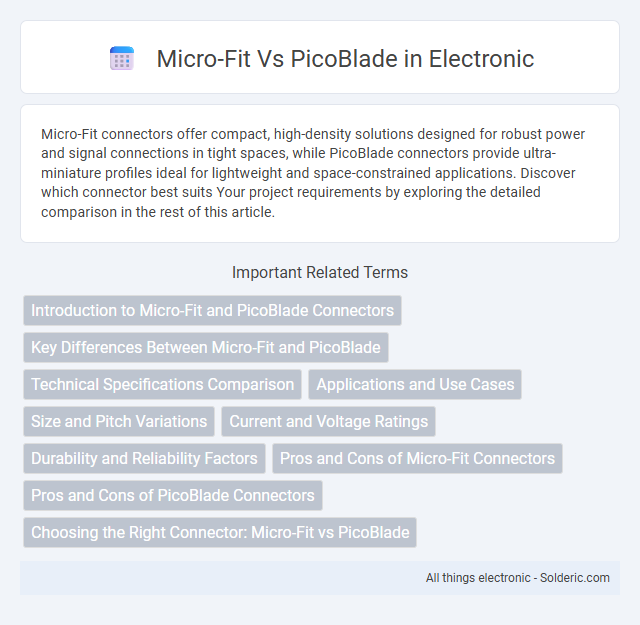Micro-Fit connectors offer compact, high-density solutions designed for robust power and signal connections in tight spaces, while PicoBlade connectors provide ultra-miniature profiles ideal for lightweight and space-constrained applications. Discover which connector best suits Your project requirements by exploring the detailed comparison in the rest of this article.
Comparison Table
| Feature | Micro-Fit | PicoBlade |
|---|---|---|
| Manufacturer | Molex | Molex |
| Pitch | 3.00 mm | 1.25 mm |
| Current Rating | 5A per circuit | 1A per circuit |
| Voltage Rating | 250V | 50V |
| Number of Circuits | Up to 24 | Up to 12 |
| Connector Type | Wire-to-wire, Wire-to-board | Wire-to-board |
| Application | Power and signal in compact spaces | Low power signal connections |
| Key Advantages | Robust, high current capability, versatile | Small size, high density |
Introduction to Micro-Fit and PicoBlade Connectors
Micro-Fit connectors from Molex offer compact, high-density interconnect solutions designed for power and signal delivery in limited spaces, supporting current ratings up to 5A and pitches of 3.00mm. PicoBlade connectors provide ultra-miniature connections optimized for low-power applications, featuring a 1.25mm pitch that suits compact electronic devices and tight design constraints. Both connector families prioritize reliable electrical performance and ease of assembly in various consumer, industrial, and automotive applications.
Key Differences Between Micro-Fit and PicoBlade
Micro-Fit connectors feature a 3.00 mm pitch, offering robust power and signal transmission suitable for moderate current applications up to 5.0A, while PicoBlade connectors have a finer 1.25 mm pitch designed for compact, low-current applications up to 1.25A. Micro-Fit connectors utilize a latch mechanism to ensure secure mating and enhanced mechanical stability, contrasting with PicoBlade's friction lock system that prioritizes space-saving design and easy assembly. The choice between Micro-Fit and PicoBlade depends on voltage and current requirements, space constraints, and the need for mechanical retention, making Micro-Fit ideal for power-intensive devices and PicoBlade optimal for miniaturized electronics.
Technical Specifications Comparison
Micro-Fit connectors offer a current rating up to 5A and a pitch size of 3.0mm, designed for power and signal applications with robust housing options. PicoBlade connectors feature a smaller 1.25mm pitch and support currents up to 1.25A, catering to compact device requirements with precision alignment. Your choice depends on space constraints and current needs, with Micro-Fit suited for higher power and PicoBlade optimized for miniaturized electronics.
Applications and Use Cases
Micro-Fit connectors are ideal for power and signal applications in automotive, consumer electronics, and industrial equipment where compact design and reliable performance are crucial. PicoBlade connectors excel in small-scale electronics and wearable devices, offering ultra-compact size and high-density pin configurations for space-constrained environments. Your choice depends on whether you need higher current capacity and durability (Micro-Fit) or minimal footprint and precision connections (PicoBlade).
Size and Pitch Variations
Micro-Fit connectors offer a 3.0mm pitch and are designed for current ratings up to 8A, making them suitable for applications requiring robust power connections in a compact form. PicoBlade connectors feature a smaller 1.25mm pitch and are ideal for low-power, space-constrained electronic devices where miniaturization is critical. Choosing between Micro-Fit and PicoBlade depends on your specific size and pitch requirements, balancing current capacity and design constraints.
Current and Voltage Ratings
Micro-Fit connectors typically handle current ratings up to 5 to 8 amps per circuit and voltage ratings around 250 volts, making them suitable for moderate power applications. PicoBlade connectors, on the other hand, are designed for lower current requirements, usually up to 1.5 amps, with voltage ratings around 50 volts, ideal for compact, low-power devices. Choosing Micro-Fit or PicoBlade depends on your device's specific current and voltage needs, balancing size constraints with electrical performance.
Durability and Reliability Factors
Micro-Fit connectors offer higher durability with robust locking mechanisms and a rated mating cycle of up to 30 times, making them suitable for applications requiring repeated connections and disconnections. PicoBlade connectors, while smaller and more compact, provide reliable signal integrity but have a lower mating cycle rating, typically around 30-50 cycles, which may affect their long-term reliability in high-use environments. Your choice between Micro-Fit and PicoBlade should consider the frequency of connector engagement and environmental stress to ensure optimal durability and performance.
Pros and Cons of Micro-Fit Connectors
Micro-Fit connectors offer a compact, high-density solution with current ratings up to 5A and excellent vibration resistance, making them ideal for automotive and industrial applications. They feature a durable housing with polarized design to prevent mis-mating but have limitations in extremely high-current environments compared to larger connectors like PicoBlade. The main drawbacks include slightly larger size and cost relative to smaller connectors, which may not suit ultra-miniature or very low-power applications.
Pros and Cons of PicoBlade Connectors
PicoBlade connectors offer a compact design ideal for space-constrained applications, providing reliable connections for low-power signal transmission with pitches typically around 1.25mm. They excel in lightweight and dense PCB layouts, but their small size can make handling and insertion more challenging, especially in environments requiring frequent mating cycles. Your choice of PicoBlade connectors should consider their balance of compactness and delicacy, ensuring they meet the durability requirements of your specific electronic project.
Choosing the Right Connector: Micro-Fit vs PicoBlade
Micro-Fit connectors offer higher current ratings up to 5A and are suitable for compact power applications, while PicoBlade connectors provide a smaller footprint with rated currents up to 1.25A ideal for space-constrained signal connections. Selecting between Micro-Fit and PicoBlade depends on the application's power requirements and available PCB real estate. The Micro-Fit series supports robust, reliable connections for moderate power loads, whereas PicoBlade excels in minimizing size for low-current, high-density wiring harnesses.
Micro-Fit vs PicoBlade Infographic

 solderic.com
solderic.com